Effect of Chain Orientation on Coupling of Optical and Mechanical Anisotropies of Polymer Films
Abstract
1. Introduction
2. Materials and Methods
2.1. Polymer Films
- 50 μm melt-casted polystyrene (PS)
- 50 μm melt-casted poly(methyl methacrylate) (PMMA)
- 50 μm melt-extruded poly(ethylene terephthalate) (PET)
- 50 μm melt-extruded poly(ethylene naphthalate) (PEN)
- 50 μm melt-extruded poly(ether ether ketone) (PEEK)
- 50 μm extruded poly(ether sulfones) (PES)
- 50 μm melt-extruded poly(ethylene chlorotrifluoroethylene) (ECTFE)
- 60 μm melt-extruded poly(phenylsulfone) (PPSU)
- and 36 and 50 μm melt-casted polycarbonate (PC)
2.2. Tension Test
2.3. Nanoindentation Test
2.4. Refractive Indices and Birefringence Measurements
2.5. X-ray Analysis
3. Results
3.1. Film Response in Tension
3.2. Z-direction Nanoindentation Response
3.3. Optical Refractive Indices, Birefringence, and WAXS
4. Discussion
4.1. Elasticity and Yielding
4.2. Post-Yield Tensile Response
4.3. Out-of-Plane Viscoelastic Response
4.4. Coupling Optical and Mechanical Anisotropies
4.5. Necking
5. Conclusions
Supplementary Materials
Author Contributions
Funding
Institutional Review Board Statement
Informed Consent Statement
Data Availability Statement
Acknowledgments
Conflicts of Interest
References
- White, M. Thin polymer films. Thin Solid Film. 1973, 18, 157–172. [Google Scholar] [CrossRef]
- Chatterjee, T.; Patel, R.; Garnett, I.V.J.; Paradkar, R.; Ge, S.; Liu, L.; Forziati Jr, K.T.; Shah, N. Machine direction orientation of high density polyethylene (HDPE): Barrier and optical properties. Polymer 2014, 55, 4102–4115. [Google Scholar] [CrossRef]
- Godshall, D.; Wilkes, G.; Krishnaswamy, R.K.; Sukhadia, A.M. Processing-structure-property investigation of blown HDPE films containing both machine and transverse direction oriented lamellar stacks. Polymer 2003, 44, 5397–5406. [Google Scholar] [CrossRef]
- Tabatabaei, S.H.; Parent, L.; Cigana, P.; Ajji, A.; Carreau, P.J. Effect of machine direction orientation conditions on properties of HDPE films. J. Plast. Film Sheeting 2009, 25, 235–249. [Google Scholar] [CrossRef]
- Kwon, O.H.; Ha, T.; Kim, D.-G.; Kim, B.G.; Kim, Y.S.; Shin, T.J.; Koh, W.-G.; Lim, H.S.; Yoo, Y. Anisotropy-driven high thermal conductivity in stretchable poly (vinyl alcohol)/hexagonal boron nitride nanohybrid films. ACS Appl. Mater. Interfaces 2018, 10, 34625–34633. [Google Scholar] [CrossRef]
- Prest, W., Jr.; Luca, D. The origin of the optical anisotropy of solvent cast polymeric films. J. Appl. Phys. 1979, 50, 6067–6071. [Google Scholar] [CrossRef]
- Kershah, T.; Anderson, P.D.; van Breemen, L.C. Uniaxial and Biaxial Response of Anisotropic Polypropylene. Macromol. Theory Simul. 2020, 29, 2000018. [Google Scholar] [CrossRef]
- Lee, C.S.; Caddell, R.M.; Yeh, G.S. Cold extrusion and cold drawing of polymeric rod: The influence on subsequent tensile and compressive mechanical properties. Mater. Sci. Eng. 1972, 10, 241–248. [Google Scholar] [CrossRef]
- López-Barrón, C.R.; Zeng, Y.; Schaefer, J.J.; Eberle, A.P.; Lodge, T.P.; Bates, F.S. Molecular alignment in polyethylene during cold drawing using in-situ SANS and Raman spectroscopy. Macromolecules 2017, 50, 3627–3636. [Google Scholar] [CrossRef]
- Robertson, R.E. On the cold-drawing of plastics. J. Appl. Polym. Sci. 1963, 7, 443–450. [Google Scholar] [CrossRef]
- Voyiadjis, G.Z.; Samadi-Dooki, A. Constitutive modeling of large inelastic deformation of amorphous polymers: Free volume and shear transformation zone dynamics. J. Appl. Phys. 2016, 119, 225104. [Google Scholar] [CrossRef]
- Boyce, M.C.; Parks, D.M.; Argon, A.S. Large inelastic deformation of glassy polymers. Part I: Rate dependent constitutive model. Mech. Mater. 1988, 7, 15–33. [Google Scholar] [CrossRef]
- Hasan, O.; Boyce, M.; Li, X.; Berko, S. An investigation of the yield and postyield behavior and corresponding structure of poly (methyl methacrylate). J. Polym. Sci. Part B Polym. Phys. 1993, 31, 185–197. [Google Scholar] [CrossRef]
- Yang, S.M.; Hong, S.; Kim, S.Y. Optical, mechanical, and photoelastic anisotropy of biaxially stretched polyethylene terephthalate films studied using transmission ellipsometer equipped with strain camera and stress gauge. J. Polym. Sci. Part B Polym. Phys. 2019, 57, 152–160. [Google Scholar] [CrossRef]
- Cimrova, V.; Neher, D.; Kostromine, S.; Bieringer, T. Optical anisotropy in films of photoaddressable polymers. Macromolecules 1999, 32, 8496–8503. [Google Scholar] [CrossRef]
- Ajji, A.; Zhang, X.; Elkoun, S. Biaxial orientation in HDPE films: Comparison of infrared spectroscopy, X-ray pole figures and birefringence techniques. Polymer 2005, 46, 3838–3846. [Google Scholar] [CrossRef]
- Pinnock, P.; Ward, I. Mechanical and optical anisotropy in polyethylene terephthalate fibres. Br. J. Appl. Phys. 1964, 15, 1559. [Google Scholar] [CrossRef]
- Ward, I. The influence of pre-orientation on the optical and mechanical anisotropy of drawn polymers. Br. J. Appl. Phys. 1967, 18, 1165. [Google Scholar] [CrossRef]
- Ward, I. Optical and mechanical anisotropy in crystalline polymers. Proc. Phys. Soc. 1962, 80, 1176. [Google Scholar] [CrossRef]
- Bridle, C.; Buckley, A.; Scanlan, J. Mechanical anisotropy of oriented polymers: Part 1 A yield criterion for uniaxially-drawn poly (ethylene terephthalate). J. Mater. Sci. 1968, 3, 622–628. [Google Scholar] [CrossRef]
- White, J.L.; Spruiell, J.E. The specification of orientation and its development in polymer processing. Polym. Eng. Sci. 1983, 23, 247–256. [Google Scholar] [CrossRef]
- Wu, M.S.S. Intrinsic birefringence of amorphous poly (bisphenol-A carbonate). J. Appl. Polym. Sci. 1986, 32, 3263–3275. [Google Scholar] [CrossRef]
- Zhang, X.; Elkoun, S.; Ajji, A.; Huneault, M. Oriented structure and anisotropy properties of polymer blown films: HDPE, LLDPE and LDPE. Polymer 2004, 45, 217–229. [Google Scholar] [CrossRef]
- Campoy-Quiles, M.; Etchegoin, P.; Bradley, D. On the optical anisotropy of conjugated polymer thin films. Phys. Rev. B 2005, 72, 045209. [Google Scholar] [CrossRef]
- Ye, C.; Singh, G.; Wadley, M.L.; Karim, A.; Cavicchi, K.A.; Vogt, B.D. Anisotropic mechanical properties of aligned polystyrene-block-polydimethylsiloxane thin films. Macromolecules 2013, 46, 8608–8615. [Google Scholar] [CrossRef]
- Li, H.; Buckley, C. Necking in glassy polymers: Effects of intrinsic anisotropy and structural evolution kinetics in their viscoplastic flow. Int. J. Plast. 2010, 26, 1726–1745. [Google Scholar] [CrossRef]
- Unwin, A.; Duckett, R.; Ward, I.M.; Collins, T.; Sweeney, J.; Coates, P.D. Suppression of necking in polyethylene. J. Appl. Polym. Sci. 2002, 86, 3135–3147. [Google Scholar] [CrossRef]
- Hossain, M.M.; Browning, R.; Minkwitz, R.; Sue, H.-J. Effect of asymmetric constitutive behavior on scratch-induced deformation of polymers. Tribol. Lett. 2012, 47, 113–122. [Google Scholar] [CrossRef]
- Hristov, H.; Bolan, B.; Yee, A.; Xie, L.; Gidley, D. Measurement of hole volume in amorphous polymers using positron spectroscopy. Macromolecules 1996, 29, 8507–8516. [Google Scholar] [CrossRef]
- Malekmotiei, L.; Voyiadjis, G.Z.; Samadi-Dooki, A.; Lu, F.; Zhou, J. Effect of annealing temperature on interrelation between the microstructural evolution and plastic deformation in polymers. J. Polym. Sci. Part B Polym. Phys. 2017, 55, 1286–1297. [Google Scholar] [CrossRef]
- ASTM D638-22; Standard Test Method for Tensile Properties of Plastics. ASTM: West Conshohocken, PA, USA, 2022.
- Briscoe, B.; Fiori, L.; Pelillo, E. Nano-indentation of polymeric surfaces. J. Phys. D Appl. Phys. 1998, 31, 2395. [Google Scholar] [CrossRef]
- Oliver, W.C.; Pharr, G.M. An improved technique for determining hardness and elastic modulus using load and displacement sensing indentation experiments. J. Mater. Res. 1992, 7, 1564–1583. [Google Scholar] [CrossRef]
- Voyiadjis, G.Z.; Samadi-Dooki, A.; Malekmotiei, L. Nanoindentation of high performance semicrystalline polymers: A case study on PEEK. Polym. Test. 2017, 61, 57–64. [Google Scholar] [CrossRef]
- Prasad, K.E.; Keryvin, V.; Ramamurty, U. Pressure sensitive flow and constraint factor in amorphous materials below glass transition. J. Mater. Res. 2009, 24, 890–897. [Google Scholar] [CrossRef]
- Samadi-Dooki, A.; Malekmotiei, L.; Voyiadjis, G.Z. Characterizing shear transformation zones in polycarbonate using nanoindentation. Polymer 2016, 82, 238–245. [Google Scholar] [CrossRef]
- Swadener, J.; George, E.; Pharr, G. The correlation of the indentation size effect measured with indenters of various shapes. J. Mech. Phys. Solids 2002, 50, 681–694. [Google Scholar] [CrossRef]
- Voyiadjis, G.Z.; Malekmotiei, L.; Samadi-Dooki, A. Indentation size effect in amorphous polymers based on shear transformation mediated plasticity. Polymer 2018, 137, 72–81. [Google Scholar] [CrossRef]
- Malekmotiei, L.; Samadi-Dooki, A.; Voyiadjis, G.Z. Nanoindentation study of yielding and plasticity of poly (methyl methacrylate). Macromolecules 2015, 48, 5348–5357. [Google Scholar] [CrossRef]
- Bodie Technology, Inc. Kornucopia® v4.0-05. Available online: www.BodieTech.com (accessed on 4 February 2023).
- Hay, J.; Crawford, B. Measuring substrate-independent modulus of thin films. J. Mater. Res. 2011, 26, 727–738. [Google Scholar] [CrossRef]
- Labonte, D.; Lenz, A.-K.; Oyen, M.L. On the relationship between indentation hardness and modulus, and the damage resistance of biological materials. Acta Biomater. 2017, 57, 373–383. [Google Scholar] [CrossRef]
- Haji, A.; Rahbar, R.S.; Kalantari, B. The effect of hot multistage drawing on molecular structure and optical properties of polyethylene terephthalate fibers. Mater. Res. 2012, 15, 554–560. [Google Scholar] [CrossRef]
- DeMeuse, M. Fundamentals of biaxial stretching and definitions of terms. In Biaxial Stretching of Film; Elsevier: Amsterdam, The Netherlands, 2011; pp. 3–13. [Google Scholar]
- Choi, M.-C.; Wakita, J.; Ha, C.-S.; Ando, S. Highly transparent and refractive polyimides with controlled molecular structure by chlorine side groups. Macromolecules 2009, 42, 5112–5120. [Google Scholar] [CrossRef]
- Kim, J.; Cakmak, M.; Zhou, X. Effect of composition on orientation, optical and mechanical properties of bi-axially drawn PEN and PEN/PEI blend films. Polymer 1998, 39, 4225–4234. [Google Scholar] [CrossRef]
- Gedde, U.W.; Hedenqvist, M.S. Fundamental Polymer Science; Springer: Cham, Switzerland, 2019; Volume 2. [Google Scholar]
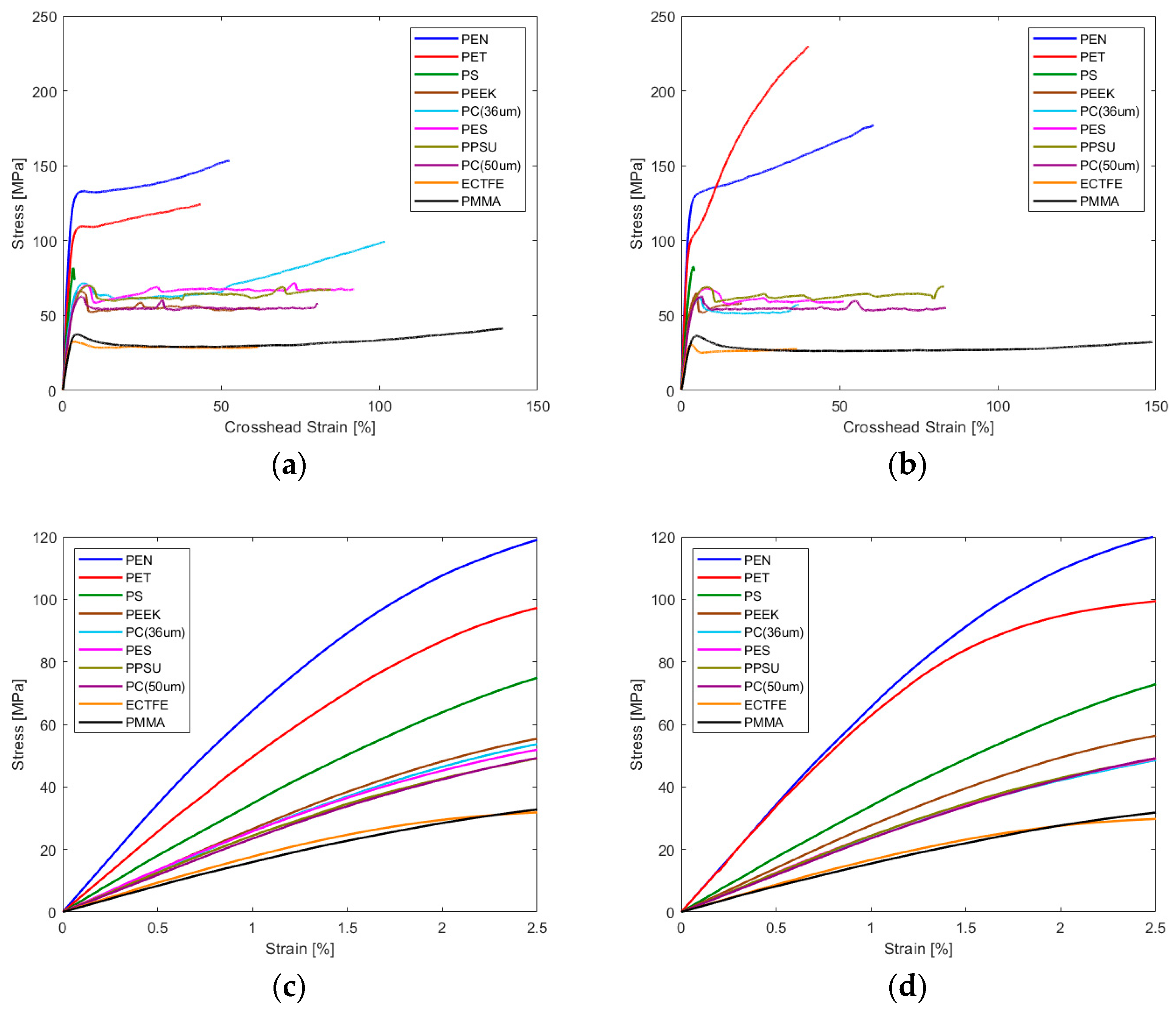
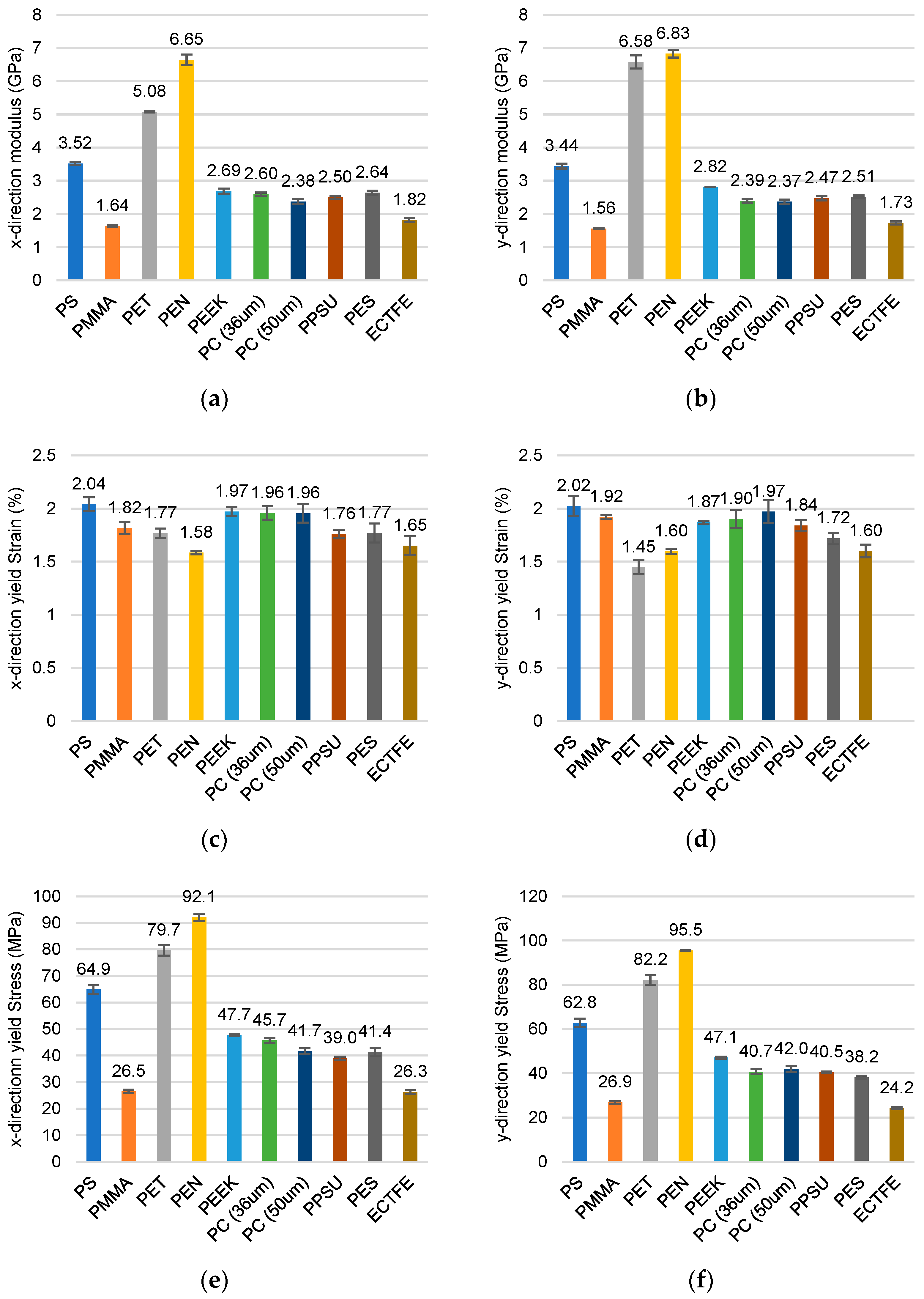
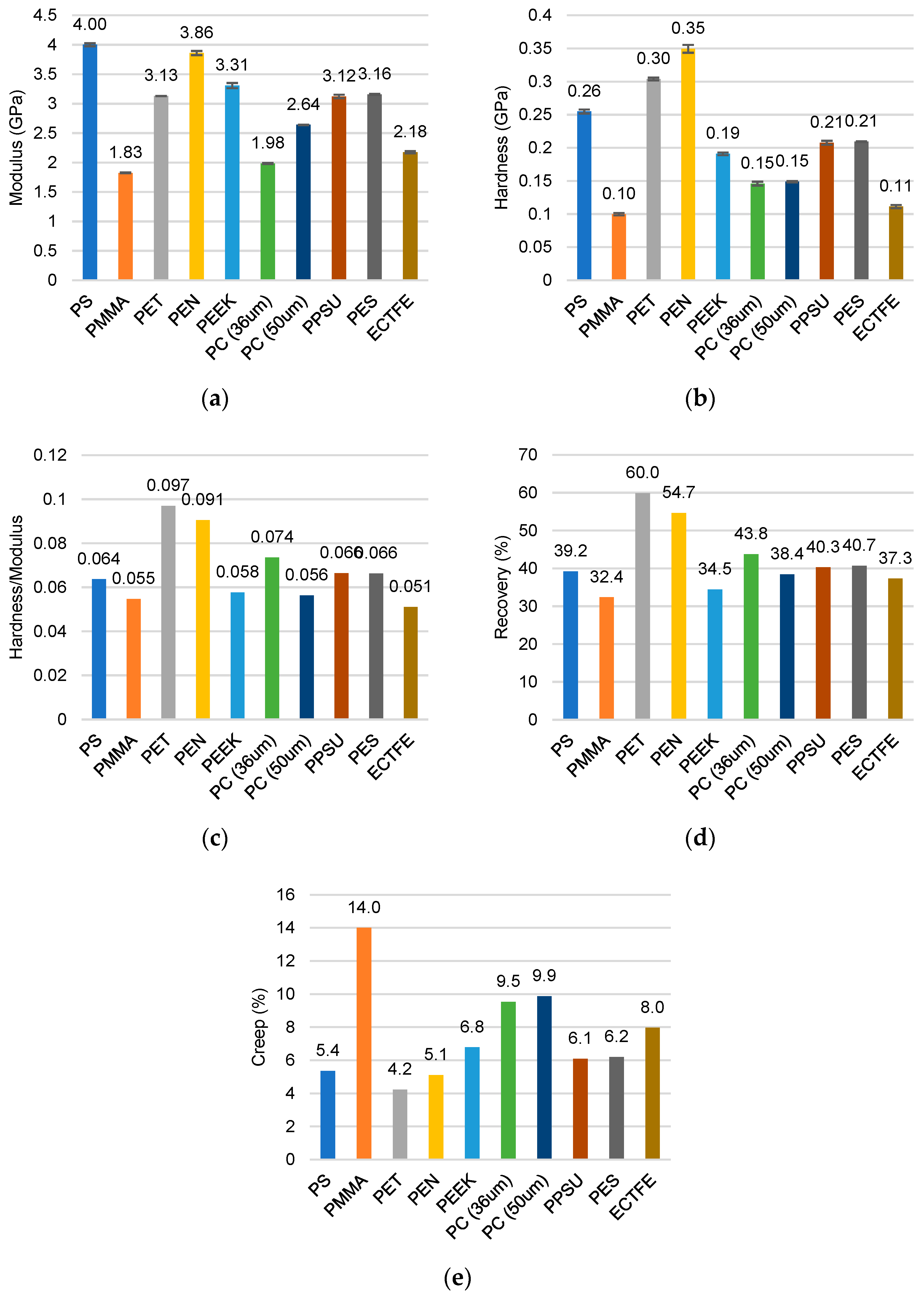




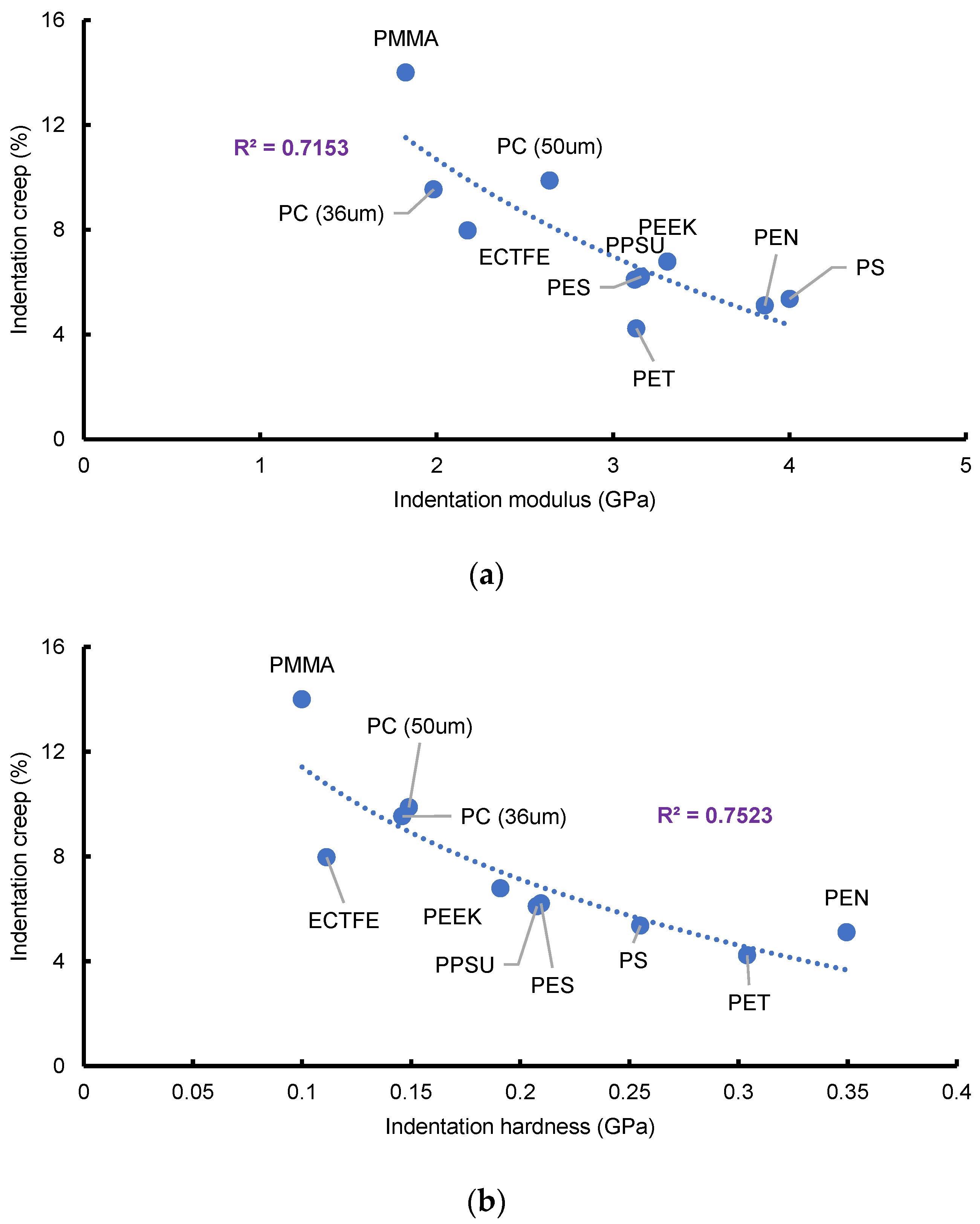
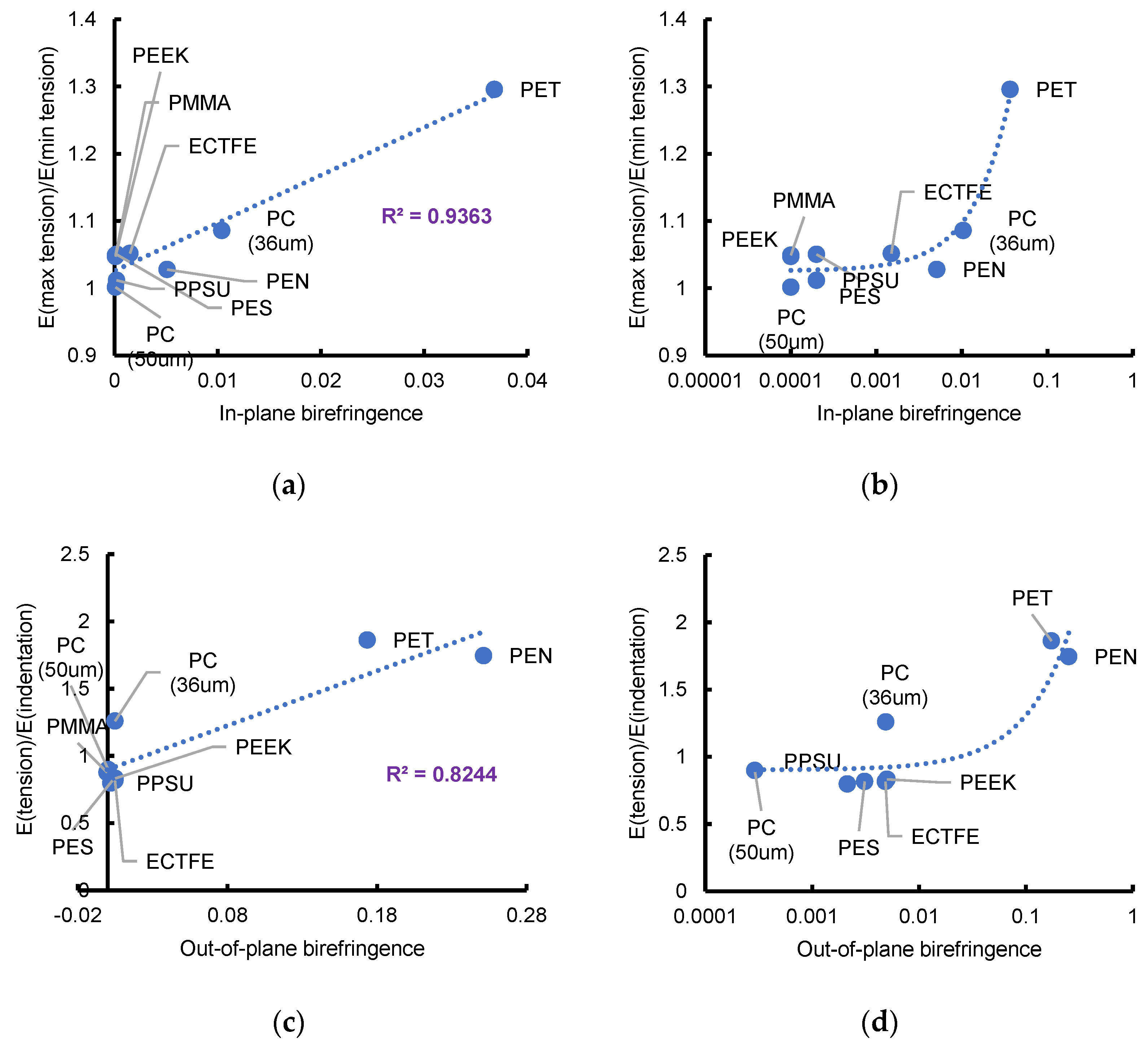
| Film | In-Plane Birefringence | Average Out-of-Plane Birefringence | |||
|---|---|---|---|---|---|
| PMMA | 1.49086 | 1.49076 | 1.49124 | 0.00010 | −0.00043 |
| PET | 1.68930 | 1.65248 | 1.49740 | 0.03682 | 0.17349 |
| PEN | 1.76878 | 1.76366 | 1.51488 | 0.00512 | 0.25134 |
| PEEK | 1.69190 | 1.69188 | 1.68688 | 0.00002 | 0.00501 |
| PC (36 µm) | 1.59598 | 1.58562 | 1.58592 | 0.01036 | 0.00488 |
| PC (50 µm) | 1.58942 | 1.58932 | 1.58908 | 0.00010 | 0.00029 |
| PPSU | 1.68286 | 1.68264 | 1.68062 | 0.00022 | 0.00213 |
| PES | 1.68256 | 1.68232 | 1.67936 | 0.00024 | 0.00308 |
| ECTFE | 1.45228 | 1.45074 | 1.44666 | 0.00154 | 0.00485 |
| Film | Herman’s Orientation Factor |
|---|---|
| PS | 0.000972 |
| PMMA | −0.00599 |
| PET | 0.8942 |
| PEN | 0.9512 |
| PEEK | −0.0155 |
| PC (36 µm) | −0.00816 |
| PC (50 µm) | −0.0225 |
| PPSU | −0.0149 |
| PES | −0.0225 |
| ECTFE | −0.0791 |
Disclaimer/Publisher’s Note: The statements, opinions and data contained in all publications are solely those of the individual author(s) and contributor(s) and not of MDPI and/or the editor(s). MDPI and/or the editor(s) disclaim responsibility for any injury to people or property resulting from any ideas, methods, instructions or products referred to in the content. |
© 2024 by the authors. Licensee MDPI, Basel, Switzerland. This article is an open access article distributed under the terms and conditions of the Creative Commons Attribution (CC BY) license (https://creativecommons.org/licenses/by/4.0/).
Share and Cite
Samadi-Dooki, A.; Lamontia, M.A.; Londoño, J.D.; Williamson, C.; Burch, H.E.; Yahyazadehfar, M.; Carbajal, L.A.; Kourtakis, K. Effect of Chain Orientation on Coupling of Optical and Mechanical Anisotropies of Polymer Films. Coatings 2024, 14, 764. https://doi.org/10.3390/coatings14060764
Samadi-Dooki A, Lamontia MA, Londoño JD, Williamson C, Burch HE, Yahyazadehfar M, Carbajal LA, Kourtakis K. Effect of Chain Orientation on Coupling of Optical and Mechanical Anisotropies of Polymer Films. Coatings. 2024; 14(6):764. https://doi.org/10.3390/coatings14060764
Chicago/Turabian StyleSamadi-Dooki, Aref, Mark A. Lamontia, Juan David Londoño, Curtis Williamson, Heidi E. Burch, Mobin Yahyazadehfar, Leopoldo A. Carbajal, and Kostantinos Kourtakis. 2024. "Effect of Chain Orientation on Coupling of Optical and Mechanical Anisotropies of Polymer Films" Coatings 14, no. 6: 764. https://doi.org/10.3390/coatings14060764
APA StyleSamadi-Dooki, A., Lamontia, M. A., Londoño, J. D., Williamson, C., Burch, H. E., Yahyazadehfar, M., Carbajal, L. A., & Kourtakis, K. (2024). Effect of Chain Orientation on Coupling of Optical and Mechanical Anisotropies of Polymer Films. Coatings, 14(6), 764. https://doi.org/10.3390/coatings14060764





